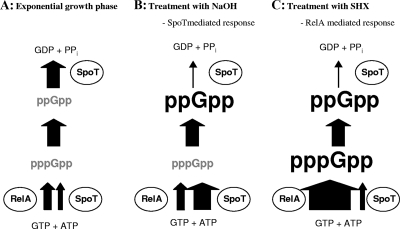FIG. 6.
Regulation of the stringent response in P. aeruginosa wild type during exponential growth (A) and in response to either NaOH (B) or SHX (C) treatment. Accumulation of nucleotides is indicated by bold letters, undetectable nucleotide levels are represented by gray letters, and synthesis or degradation rates are indicated by the size of arrows. Conversion of pppGpp to ppGpp is mediated by a polyphosphate kinase (Ppx). (A) ppGpp and pppGpp metabolism during exponential phase is characterized by an equal rate of pppGpp synthesis and ppGpp degradation. (B) Treatment with NaOH induces a SpoT-regulated stringent response. The accumulation of ppGpp is achieved by a decrease in the ppGpp degradation process, resulting in lower ppGpp degradation rates than synthesis rates. (C) Treatment with SHX induces mainly a RelA-mediated stringent response, resulting in increased synthesis rates of pppGpp. In this case both, pppGpp and ppGpp accumulate in the cell. However, a reduction in ppGpp degradation by SpoT was also described under these conditions in E. coli (41).

